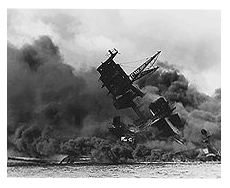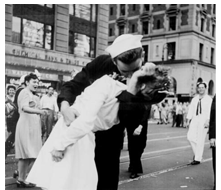



World War II affected every single person in the United States for years. While much curriculum in older grades focuses on chronology, personalities, battles, and diplomacy, younger students can learn a great deal about community and working together by exploring how American communities, including children, responded to the war.
In this section you can take your students back in time to when radios spread the news of the day and every child participated in War Bond campaigns, scrap drives, and Victory garden planting. They will learn about communities in the 1940s and how that “We're all in this together” spirit can be recaptured in our communities today.
 Before you can understand why the whole world went to war, you have to know that it was not the first time. World War I, then called the Great War (they didn’t know there would be a second one) was fought from 1914-1918. When the war was over, the winners, including the United States, harshly punished the losers, mostly Germany. Things were tough for Germans after World War I. In fact, they were tough for everyone. The United States and the rest of the world went through the Great Depression in the 1930s.
Before you can understand why the whole world went to war, you have to know that it was not the first time. World War I, then called the Great War (they didn’t know there would be a second one) was fought from 1914-1918. When the war was over, the winners, including the United States, harshly punished the losers, mostly Germany. Things were tough for Germans after World War I. In fact, they were tough for everyone. The United States and the rest of the world went through the Great Depression in the 1930s.
 When times are bad, people often turn to those who promise that things will get better. In Germany, that man was Adolf Hitler. Hitler led a group called the Nazis, and once he came to power, he was able to convince many Germans that others were to blame for Germany’s difficult times. He built up an army and took away rights of those who he said were not true Germans. At the same time across the world, in Japan, the Japanese Emperor was telling his people that it was their right to conquer other countries to get the supplies needed to make Japan into a mighty nation.
When times are bad, people often turn to those who promise that things will get better. In Germany, that man was Adolf Hitler. Hitler led a group called the Nazis, and once he came to power, he was able to convince many Germans that others were to blame for Germany’s difficult times. He built up an army and took away rights of those who he said were not true Germans. At the same time across the world, in Japan, the Japanese Emperor was telling his people that it was their right to conquer other countries to get the supplies needed to make Japan into a mighty nation.
 The German Army went to war with France, Great Britain, and other European countries in 1939. The United States did not get involved right away. But on December 7, 1941, Japan attacked U.S. ships, planes, and people at Pearl Harbor, Hawaii. The U.S. President, Franklin Delano Roosevelt, declared war on Japan, and then Germany declared war on the United States. Nearly the whole world was at war. The U.S. fought with the Allied nations, including Great Britain, Canada, Australia, China, and the Soviet Union. Germany and Japan were on the other side, and were called the Axis nations. Fighting raged throughout Europe, much of Asia and throughout the Atlantic and Pacific Oceans.
The German Army went to war with France, Great Britain, and other European countries in 1939. The United States did not get involved right away. But on December 7, 1941, Japan attacked U.S. ships, planes, and people at Pearl Harbor, Hawaii. The U.S. President, Franklin Delano Roosevelt, declared war on Japan, and then Germany declared war on the United States. Nearly the whole world was at war. The U.S. fought with the Allied nations, including Great Britain, Canada, Australia, China, and the Soviet Union. Germany and Japan were on the other side, and were called the Axis nations. Fighting raged throughout Europe, much of Asia and throughout the Atlantic and Pacific Oceans.
 Five years after the war started, the Allies, led by General Dwight Eisenhower, invaded France in order to push the Germans out. June 6, 1944, was called D-Day. The Allies landed on the beaches in northern France and fought hard for nearly another year until the Germans finally surrendered in May 1945.
Five years after the war started, the Allies, led by General Dwight Eisenhower, invaded France in order to push the Germans out. June 6, 1944, was called D-Day. The Allies landed on the beaches in northern France and fought hard for nearly another year until the Germans finally surrendered in May 1945.
In the Pacific Ocean, the Americans fought Japan on island after island trying to get closer to Japan. The Allies called this island-hopping. Finally, in August of 1945, the Americans used a brand new kind of weapon—atomic bombs—on the Japanese cities of Hiroshima and Nagasaki. The Japanese could see that they must surrender.
 The war was not easy for either side. Many millions of people lost their lives. Many of them were not even soldiers. The Jewish people of Europe suffered greatly because of hate and intolerance. When World War II was over, the world swore that they would learn from the lessons of the war so that it would never happen again. Today, we study World War II so that we can learn from both the mistakes and the successes of the past.
The war was not easy for either side. Many millions of people lost their lives. Many of them were not even soldiers. The Jewish people of Europe suffered greatly because of hate and intolerance. When World War II was over, the world swore that they would learn from the lessons of the war so that it would never happen again. Today, we study World War II so that we can learn from both the mistakes and the successes of the past.